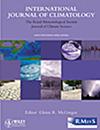摘要
本文基于ERA-5再分析数据和1980-2019年6 - 8月的观测数据,采用客观识别技术对tpzsl进行了识别,并对其进行了详细分类。在青藏高原东北(NE)、西北(NW)、东南(SE)和西南(SW)的不同分区中,揭示了tpzsl的时空分布特征和动力热力学特征。结果表明,该区每年平均产生93个强强强热带气旋,日变化显著:下午至夜间优先发生,中午有消散高峰。TPZSLs多发生在76°~ 103°E、29°~ 36°N范围内,集中在青藏高原中部和西部76°~ 85°E、32°~ 35°N区域。TPZSLs以东西方向为主(72.9%),大部分TPZSLs保持静止(58.7%)。区域间tpzsl水平和垂直尺度差异显著,水平尺度在东南最大,垂直尺度在西南最深。除西南偏南外,其他区域均随海拔升高向北倾斜。500hpa的TPZSLs均位于正涡度区;值得注意的是,西北偏西的中高压带状带状气旋位于最大涡度中心的北部,而其余的中高压带状气旋则与最大涡度中心相交。西北、西南和东南的tpzsl位于辐合带内,辐合中心位于这些切变线的东端和西端。在垂直方向上,西北和东北的TPZSLs嵌入上升气流中。除青藏高原东北部地区外,其余地区均位于高温高湿地区。本研究为进一步了解TPZSLs的发生和进化过程提供了重要的参考。




The Tibetan Plateau (TP) zonal shear line (TPZSL) is one of the most typical precipitation-producing weather systems over the TP. In this paper, based on ERA-5 reanalysis data and observation data from June to August 1980–2019, TPZSLs are identified by objective identification technologies and then classified in detail. The spatiotemporal distributions and the dynamic and thermodynamic characteristics of TPZSLs are revealed in different subregions of northeast (NE), northwest (NW), southeast (SE) and southwest (SW) TP. Results show that an average of 93 TPZSLs generate each year with a striking diurnal variation: a preferential genesis during afternoon to night and a wee-hours dissipation peak. TPZSLs occur frequently in the range of 76° ~ 103°E, 29° ~ 36°N and are concentrated in the area of 76° ~ 85°E, 32° ~ 35°N in the central and western TP. TPZSLs are mainly oriented in the east–west direction (72.9%), and the majority of TPZSLs remain stationary (58.7%). The horizontal and vertical scales of TPZSLs vary significantly across subregions, with the largest horizontal scale in the SE and the deepest vertical scale in the SW. Except for the southwestern TPZSLs, TPZSLs incline northward with increasing altitude. All TPZSLs at 500 hPa are within areas of positive vorticity; notably, TPZSLs in NW are positioned north to the maximum vorticity centre, while the remaining TPZSLs intersect the centre. TPZSLs in NW, SW and SE are situated within convergence zones where convergence centres are situated at eastern and western ends of these shear lines. Vertically, TPZSLs in the NW and NE are embedded within ascending airflow. Except for those in the northeastern TP, all TPZSLs are located within the high-temperature and high-moisture areas. This research serves as an essential reference for comprehending the genesis and evolutionary processes of TPZSLs.

 求助内容:
求助内容: 应助结果提醒方式:
应助结果提醒方式:


